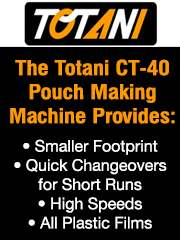Controlling costs challenge label stock, liner suppliers
- Published: January 01, 1995
Labels are being asked to meet many demands faster and at a lower cost, including durability, environmental compatability and graphic distinction, and suppliers are spear-heading as many solutions as possible to satisfy this growing, volatile market, according to label-stock and liner suppliers recently surveyed by Paper, Film & Foil CONVERTER.
Advances in film formulations continue to allow suppliers to offer thinner substrates to reduce costs and satisfy the environmental need for source reduction. One of the biggest trends in labels and liners is the use of thinner substrates, according to Chuck Stone, sales manager/roll products, Ritrama Duramark, Minneapolis, MN.
"Where we have 1 1/2 and 2 mil now, we're going to 1 and 1 1/2 mil," he said. "This makes formulation as well as production a challenge. We have to work with the resin people and the press manufacturers."
Keeping costs down while maintaining or improving performance and production levels is the primary concern.
"The biggest challenge is the price of raw materials keeps going up, pushing our costs exponentially, and we're caught in the middle because we can't pass that expense on," Ian Dodd, president, Madico, Woburn, MA, said. "Our customers - converters - demand lower prices, and they'll go to another supplier to get them. We have to find ways to keep costs down."
"Labels and liners are very volatile," Rick Sterling, sales and marketing manager, Fletcher Paper, Alpena, MI, said. "Pulp and resin prices are jumping."
"With the cost of polyester going up, we're looking for lower-cost alternatives, and that trend will continue for the next several years," Mark Panozzo, marketing manager, Release International, Oak Brook, IL, said. "Polypropylene is being looked at. It offers several benefits, like minimized machine-direction stretch. We also see an increased use of polypropylene-coated papers."
A lot of developmental work is based on efforts to decrease costs, according to Jeff Robinson, market-development specialist/packaging, FLEXcon, Spencer, MA. "End users keep pushing for lower costs, and the price of raw materials keeps going up," he said.
"The price of raw materials is adding another challenge," Stone said. "One viable alternative to polyester is metallized polypropylene, which would add no cost and, in some cases, might be stronger and cheaper. Polypropylene is gaining among converters as they get used to handling it.
"Growing significantly for roll-to-roll applications across the board is silicone-coated polypropylene," he said. The newest developments in liners are silicone-coated 2-mil polypropylene and 1 1/2-mil polyester, and there's talk about pressure-sensitive release liners. The film-based products aren't perfect yet. There are some static issues and some extensibility issues to be worked out.
"We're working to develop stronger substrates that are less extensible for the growing narrow-web market," Stone said.
The use of metallized paper and films to replace foil laminates is still going strong, according to Christine Lippy, marketing manger, Camvac America, Bellwood, IL. "Most of the conversions from foil laminates to metallized paper and film are almost done. In general, more metallized substrates are being used in food-product labels. The trend is toward using metallized in-mold labels."
There's a demand for high-performance films at low cost and films and face stock that are environmentally acceptable, according to FLEXcon's Robinson.
"It's more important for label films to be flexible enough to perform with several processes because UV flexo/letterpress and combination screen/letterpress are becoming standard," he said. "Label converters are expanding to include more processes. It's the most logical way to increase market share. The label stock and liners they offer need to be as flexible as possible to make these expanded operations price competitive."
According to Panozzo, "in the prime-label market, film face stocks are replacing paper at a rate of about 15% a year compared to overall market growth of about 9% a year." Opaque and clear film stock is required for end-user applications.
"Film is needed for the no-label look because adhesive wetout is critically important," he said. "In the secondary-label market, I see only electronically-imaged labels, showing significant growth. We expect to see an extended use of low basis-weight clay-coated papers and silicone-coated kraft."
Over the next couple of years, liners will continue to be a more important part of the label system," Panozzo said. "We see 80-lb. to 100-lb. release liners that stay with the label and add stiffness to the end-use structure."
"Wherever you can have paper labels, you can have plastics," Sam Kalyanam, process engineer, Fasson Films, Painesville, OH, said. "Plastic label stock is being requested more often for applications like clothing, bar codes, injection-molded bottles and drum labels," he said.
But not everyone is looking to plastic substrates for labels.
"People are going away from film," Charles Robbins, manager, coated products, Fletcher Paper, said. "There's a question as to what to do with it after the package or bottle is disposed of. Just because you have a polyester bottle and a polyester label doesn't mean you have an easily-recycled compatible system.
"Formulators are putting more emphasis on papers becoming more dimensionally stable," he said. "This is a difficult thing. There is a greatly growing interest in silicone-coated papers, especially for release liners."













